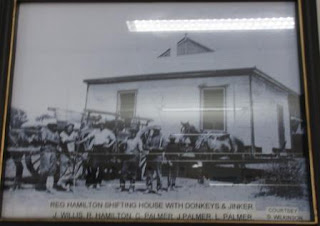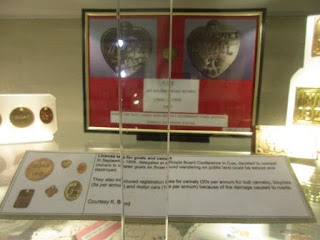7.30am
15.5 degrees, clear sky and no wind – yeah.
Drove
into town and parked near the Museum. Steve headed over to the Mines
Department. The Museum had three rooms with lots of information about the area,
mining etc and then there were sheds outside with lots to see and read too.
A
hearse which was made in Mt Magnet has been restored.
The
town in flood – there is a small creek that runs through town.
Lots
of photos.
A
wind-powered stamper.
The
Great Fingall Mine at Day Dawn.
There
are deep underground mines too and a few are still active. The Hill 50 Mine was
behind the Poverty Flats area where the first gold was found in 1891. Hill 50
closed in 2005 and its decline was approaching Level 24 making it the deepest
gold mine in Australia. Hard to imagine all those tunnels going down.
The
Morning Star went along way down too. Its pit is impressive too.
Another
mine.
Hopefully
we will be lucky like this chap but I think all the land is covered by leases
now so we mightn’t have any luck.
WA
Stamps – I have one of the swan ones.
Amazing
story of a young boy’s heroics though it was just how they survived in those days.
It doesn’t say what the mother died of but it was probably Typhoid. At least he
was recognised for his bravery.
A
beautiful organ – fantastic to think of this items being transported out here
in the dust and so far from anywhere.
Sad
story of a local war hero – after flying so many missions he died in a
motorcycle accident just after returning home. The airport has been named in
his honour.
Licences
for goats and camels so strays could be killed!! The beginning of dog
licencing.
We
were chatting to a couple at Big Bell who had been looking for relics and he
had found a small clear marble. Maybe it was from one of these bottles. The
marble was held against the rubber seal in the neck of the bottle by gas
pressure. We have seen heaps of the torpedo bottle bottoms.
An
ochre mine in the Weld Ranges.
Lots
of different ‘gold’ things. (one day I will work out why these turn sidewards)
Big
scales for big gold.
The
Cricket Ball Nugget should be called The Pick Nugget as the pick became stuck
in the nugget.
Outside
is the poppet head from the Hill 50 Mine.
Into
a big shed for more info on the Rabbit Proof Fence and Murders!! The cause of
the rabbit plague is generally accepted to be the introduction of 24 rabbits in
1859 by Thomas Austen of Barvon Park near Geelong, Victoria. By the 1890s the
rabbits were in plague proportions with hundreds of thousands being poisoned in
NSW. It was decided to build a fence to stop them getting to the crops of WA.
No. 1 Fence was the longest line of unbroken fence in the world. It stretches
1,139 miles from Starvation Harbour on the South Coast to a point near Cape
Keravdren on the North West coast. On completion it was maintained by boundary
riders. Bicycles were used initially – imagine that! Then they changed to
camels. They were also used in building the fence as most of the area was
inhospitable country. Richard Anketell was responsible for the construction of
the greater part of the No. 1 Fence which took from 20 August 1904 to 30 Sept,
1907. During this period he controlled a workforce of 120 men, 350 camels, 210
horses and 41 donkeys with an average load for transport of 375 miles.
The
replica hut that was made for the film, ‘3 Acts of Murder’, was re-erected here
by the Museum. In 1930 Arthur Upfield was writing a book as he worked at the
Camel Breeding Station that was operating on the Rabbit Proof Fence 163 miles
north of Burracoppin, from where that section of the fence was started in 1905.
He was discussing how to plan a ‘perfect murder’. A chap known as ‘Snowy
Rowles’ (John Thomas Smith) and had escaped police custody in Dalwallinu and
had worked around the Murchison under the assumed name. He said you could kill
someone then burn them. After that crush up the bones in a dolly pot and
scatter the remains. Apparently he poisoned two men by putting Strychnine in
the stew in December 1929 then shot another man in May 1930. When Upfield
published his book the police were arresting Rowles and they noticed the
similarity in the book hence they panned the ashes looking for bones. There was
the question as to whether Upfield was also responsible for putting the idea in
Rowles’ head. Rowles was convicted and hung though he proclaimed his innocence
the whole time.
ABC
did a two-part series on the murders too, ‘Blood in the Sand’ and the locals
from Mt Magnet and Cue played their roles well.
A
few other unexplained murders are still unsolved.
There
was a rest area with a few funnies to read.
In
the next shed was pastoral equipment.
Another
shed holds the Boogardie State Battery – another township to the west of Mt
Magnet. It commenced operation in 1903 and treated over190,000 tons of ore for
a return of in excess of 113,000 ounces of gold bullion. The battery was
removed from its site in 1998 due to expansion of mining operations in the
Saturn Open Pit Gold Mine. The Mt Magnet Historical Society negotiated with the
Western Mining Co for its relocation rather than destruction.
There
was a rock driller and lots of other bits and pieces.
One
couple’s portable dry blower.
Mt
Magnet Gold Operation risk management poster shows all the different pits and
underground mines.
A
very interesting museum. I asked the lady about the outdoor cinema here but she
said it was operational at the moment, usually in summer. One day we will get
to go to one as there are only a few left.
Steve
was back from the Mines Department and no there are many spots to detect unless
you know someone who has a small lease.
Leanne
& Rick rang – they have arrived in the campground at Mt Panorama. Texted
Lou to see if he was still going but work commitments have stopped him from
getting away.
We
followed the tourist drive map out to Poverty Flats which is now all fenced off
by Ramelius Mining. Behind the flats is the old Hill 50 Mine area.
Continued
around to Mt Warramboo and up to the Lookout on one side of the mount.
Originally it was named Mount Magnet, due to the magnetic nature of the rocks,
by explorer Robert Austin in 1854. He was leading the first Colonial and truly
epic expedition though this semi-arid North Eastern interior. It wasn’t till
1878 that pastoralists started to settle here, walking in Merino sheep from the
coast. Ten years later prospectors followed their tracks and shepherd wells,
finally discovering gold here. Mount Magnet is the longest continuous
goldmining centre in WA. The Surveyor General renamed the hill by its indigenous
name, Mt Warramboo meaning ‘camping place’ in 1972. Great view over the Morning
Star pit.
Plenty
of new hills all around the area.
A
bit of information on another shiny board!
Chatted
with an English man who comes over for 4 months and tours around Australia.
Very interesting chap. Steve got out the gold to show him.
We
walked up a track to see if we could get to the top where the big towers were.
Found a shaft on the way and lots of rubbish.
Good
view over mining areas to Mt Magnet township.
Track
headed down the hill so we went back to the truck and van and headed down the
road. There is a straight 4WD only track up to the towers so we gave that a
miss with the van on the back!!
Passed
three huge tailings dams around the edge of Checker Mill.
Further
along the track we found a grave site of a mother and child whose identity is
unknown but they died in the plague (typhoid) in 1908. The buried them where
they died in those days.
Around
to the breakaways to check out the ‘Amphitheatre. For over 80 years this
interesting rock formation has been a favourite spot for locals and visitors.
Something
has been using this cave as a toilet or it is something leaching from above.
Nice
view.
More
pretty wildflowers.
There
was a road going straight up to a cave on the next breakaway so climbed up to
check it out – bit hairy as it was loose dirt.
View
back to the Amphitheatre.
Made
it back down then walked around the back of the Amphitheatre where people have
been leaving messages on the ground with quartz rocks.
Drove
a bit further along and came to the official ‘Cave’ but it wasn’t as good as
the other one.
Back
to town to follow the heritage walk. First stop was the School Masters
residence, made of mud brick and built in 1898. For four years the entire
school consisted of one room only. It remained the SM residence till the 1970s.
Next
door was the old Primary School. The stone section was built in 1900. When the
Lennonville township lost its population, its school (opened in 1898) was
dismantled, transported to Mt Magnet and attached to the existing stone
building. The next section, the infant’s room, was built about 1940 and the
last section at the back was constructed about 1960.
Across
the road is the old Post Office and residence which was established in 1893.
Out
on the main road is the old WA Bank Manager’s residence. The Bank opened its
branch in 1896. About 1943, Jack Butler the town bookie, owned the house and it
is said it was the best house in town. Under every floor in the house was a
trap cut into the floorboards.
The
Shire Offices. The township was surveyed in 1894 and gazetted on 18 January,
1895. The foundation stone was laid on 23 September 1898.
The
Grand Hotel was built from locally made mud bricks about 1930 after the original
one burnt down.
Mt
Magnet Hotel was built of mud bricks too in 1896 and was then known as the
‘Oasis Hotel’. It was only a single story building then. About 1936 the front
of the building was remodelled and the second story added. After 1945 the owner
changed the name to ‘Capitol Hotel’ but it was later changed to Mt Magnet
Hotel.
Walked
across the bridge over the creek.
Lots
of beautiful roses around town.
The
outdoor cinema.
Back
to the Granites but we went further in another track and further around to park
up for the night.
The
wind has stopped so it is a bit warmer and very nice to be outside by the fire
after the sun has set and the flies have stopped buzzing!!












































































































































No comments:
Post a Comment